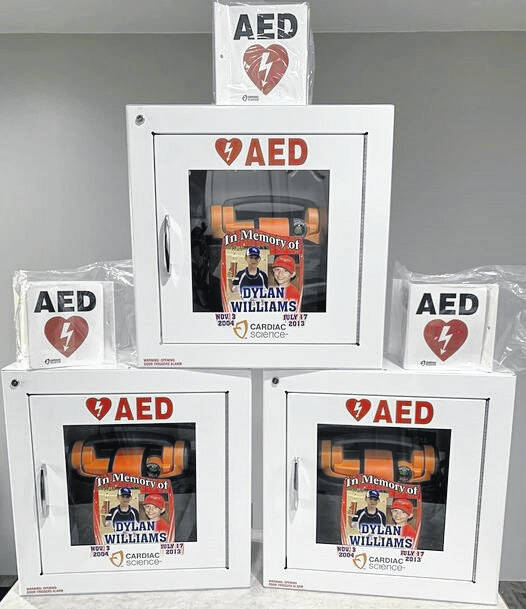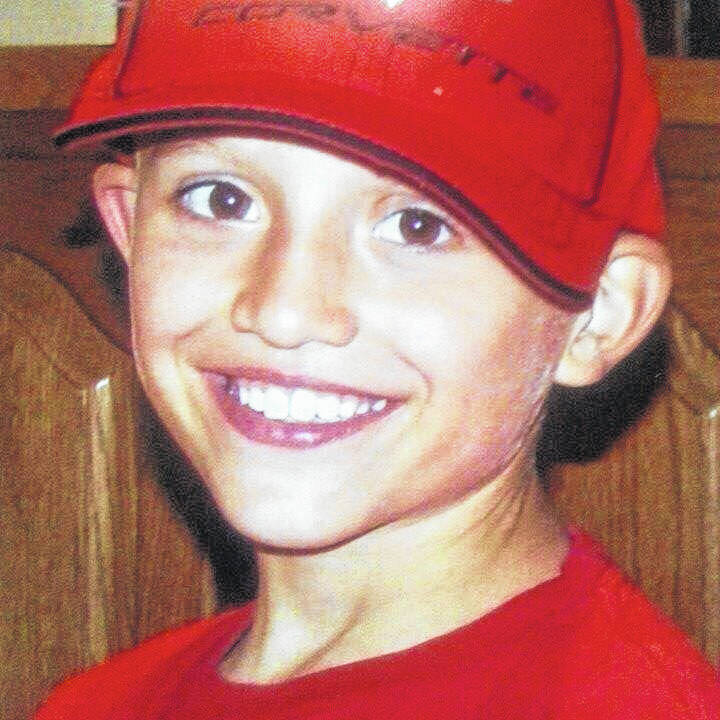
Pictured are AEDs purchased through the Dylan Williams Forever an All Star Foundation whose mission is to “bring awareness of the importance of CPR training and the placement of life-saving AEDs at youth sporting fields.”
Dylan Williams Forever an All Star Foundation Facebook page

Dylan Williams’s life was tragically cut short when he suffered sudden cardiac arrest (SCA) while playing baseball in 2013.
Dylan Williams Forever an All Star Foundation Facebook page

Now in its 10th year, the foundation has donated approximately 150 AEDs across four states.
Dylan Williams Forever an All Star Foundation Facebook page
By Dawn Hatfield
DailyAdvocate.com
UNION CITY, Ind. — During a Monday Night Football game on Jan. 2, at the Cincinnati Bengals’ Paycor Stadium, Buffalo Bills safety, Damar Hamlin, 24, suffered cardiac arrest after a tackle on Bengals wide receiver, Tee Higgins. NBCchicago.com reported on Jan. 3 that cardiopulmonary resuscitation (CPR) and automated external defibrillation (AED) were quickly administered during the 19 minutes Hamlin was collapsed on the field. Hamlin was then rushed to University of Cincinnati Medical Center in critical condition. Hamlin later was transferred to Buffalo General and, after showing considerable signs of improvement, was reportedly discharged nine days following the incident so his rehabilitation could continue at home.
In a Jan. 17 article, The Seattle Times stated, “The on-field medical personnel have been rightfully credited in providing Hamlin’s initial, lifesaving care—Bills’ Assistant Athletic Trainer Denny Kellington’s prompt CPR has been repeatedly highlighted.” The Seattle Times goes on to argue, “It is great [Hamlin] received immediate, effective care, but what if he were not an NFL player?”
This is a question Erick and Georgiana Williams of Union City, Ind., unfortunately were called to answer in 2013 when their son, Dylan, suffered sudden cardiac arrest (SCA) while playing baseball and tragically passed away. According to dwforeveranallstar.org, “At the time, Dylan was only eight years old. During an All-Star practice, he was accidentally struck in the neck area by a baseball. The blunt force of the ball caused the rhythm of his heart to become distorted, and he went into immediate cardiac arrest. When he collapsed on the field, coaches and parents started CPR and called 911, but, by the time emergency responders arrived, it was too late. At the time of the accident, there was no AED at the ballpark where Dylan was practicing.”
Though the Williams family’s loss is immeasurable, so is the impact of what they did next. To keep Dylan’s memory alive, they started the Dylan Williams Forever an All Star Foundation with the mission to “bring awareness of the importance of CPR training and the placement of life-saving AEDs at youth sporting fields.” To date, the foundation has donated approximately 150 AEDs across Indiana, Ohio, Virginia, and North Carolina.
The foundation is proud of the assistance they’ve provided, especially in the local area. “We’ve done every Randolph County high school and every Darke County high school as well. They’ve all had at least one [AED] donation from us… and a lot of the schools, we’ve donated more than one to. That way they can have them at their outside facilities, like their baseball [diamonds] and football fields,” said Erick Williams.
Williams continued, “Some of the newer stuff we’ve been doing includes Life Skills for seniors in the local school here. Part of that is becoming CPR- and AED-trained.”
Randolph Eastern School Corporation posted a major accomplishment to Facebook in November: “I am happy to announce that for the first time we had 100 percent of our seniors receive their CPR certification! A big thank you goes out to Tim Puccini and Cobie Wells for giving their time to teach the class and to The Dylan Williams Foundation for once again providing the funds.”
“This would have been Dylan’s senior year, so a lot of his classmates have been here all along,” Georgiana Williams added.
The Dylan Williams Foundation has also partnered with the Murray family from Brownsburg, Ind., to place an AED in every police car in the town after their son Brooks collapsed during a track meet at Brownsburg High School in May 2016 due to sudden cardiac arrest. There was an off-duty police officer in attendance to watch his own son compete, but at that time, BPD did not have AEDs in all of their cars. Brooks’ life was saved thanks to three bystanders who performed CPR for seven minutes to revive him.
Sadly, this is often not the outcome.
Macgill.com wrote in July 2022, “SCA claims the lives of over 2,000 children and adolescents, with two in every 50 high schools experiencing at least one sudden cardiac arrest event each year… ensuring an AED is in every school should be a priority.”
“A study conducted by the Children’s Hospital of Philadelphia found SCA to be the leading cause of death in young athletes. A young athlete dies suddenly every three days… Despite these statistics, though, fewer than 20 states have enacted legislation requiring AEDs to be in public schools. Only nine of these states have provided funding. School athletic programs must be equipped with AEDs and they should always be present on the sidelines of athletic practices and events,” reports AEDuse.com.
Similarly, SimonsHeart.org argues, “All schools have fire alarms, smoke detectors, and fire extinguishers. However, most are not required to have automated external defibrillators. AEDs are life-saving devices that should be a fixture in all schools nationwide.”
At least one Ohio lawmaker agrees. On Jan. 6, 2023, the following statement was released: “State Rep. Richard Brown (D-District 5) announced he will reintroduce legislation that would require automatic external defibrillators (AEDs) to be placed in public schools, chartered non-public schools, community schools, STEM schools, college-prep boarding schools, and public recreational facilities in Ohio.”
Rep. Brown was quoted as saying, “Sudden cardiac arrest is the leading cause of sudden death in young athletes. This is not about if, but when. I want to make sure we are putting our students, families, schools and organizations in the best position possible to handle these situations when they arise.”
The statement continued, “House Bill 426 was introduced in the last General Assembly, but only received one hearing in the Primary and Secondary Education Committee. Rep. Brown plans to reintroduce this legislation in the current General Assembly as soon as practical.”
Many in Indiana hope a comparable bill, SB306, soon passes in their state senate.
While citizens often recognize the benefit of having accessible AEDs in the community, and especially where youth practice athletics, it is not obvious who should foot the bill. According to Williams, an entire AED package, which includes a talking automatic external defibrillator, carrying case, ready kit, storage case, signage, and extra pads set, retails for about $2,500. Even as a non-profit, the Dylan Williams Forever an All Star Foundation’s cost is approximately $1,500. Some communities and/or teams and organizations simply cannot afford the price tag.
On the other hand, what is the cost of not having AEDs readily available?
At the time of publication, neither Rep. Angela N. King (R-District 84) nor Rep. Jena Powell (R-District 80), representatives for Darke County, responded to The Daily Advocate with comments regarding HB426 as requested on Jan. 11, 2023.
Follow Dylan Williams Forever an All Star Foundation on Facebook to donate to the foundation or related causes, to coordinate fundraising/raise awareness, or to learn about the 10th Annual Dylan Williams Memorial Invitational to be held at Dylan Williams Memorial Ball Park in Union City, Ind., in June 2023. Visit RedCross.org to enroll in an online or local AED, CPR, or other emergency training class. Contact your state representatives at OhioHouse.gov. Reach Daily Advocate Reporter Dawn Hatfield at [email protected] or 937-569-0066.




